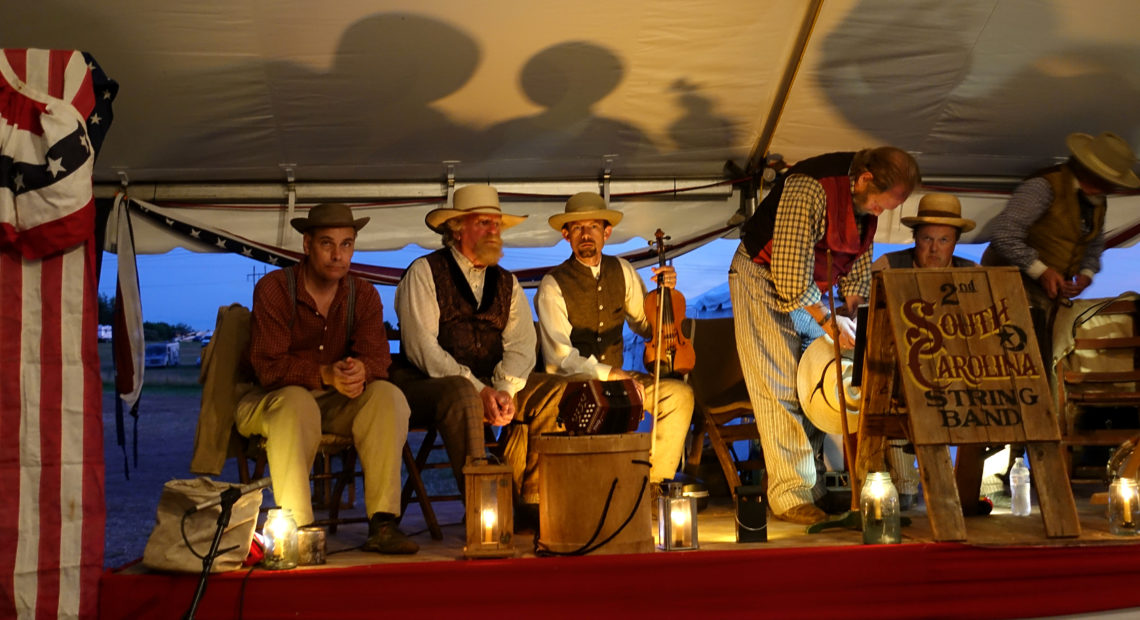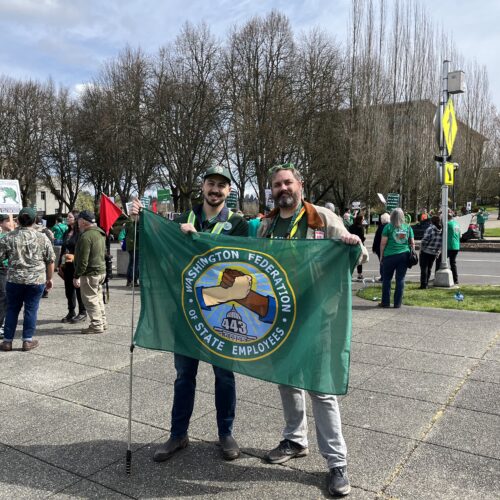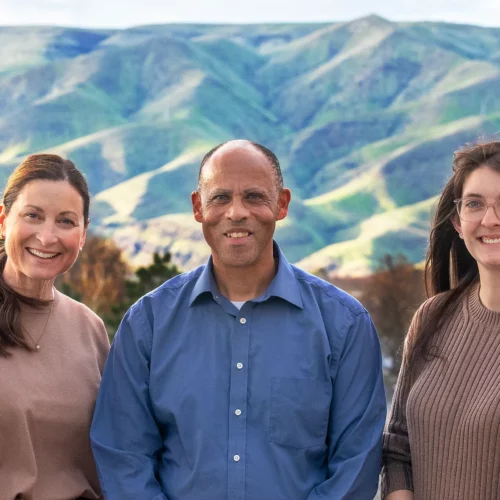
The Anthemic Allure Of ‘Dixie,’ An Enduring Confederate Monument
PHOTO: The 2nd South Carolina String Band in July, onstage in the main tent of the annual reenactment of the Battle of Gettysburg. CREDIT: Bilal Qureshi for NPR
BY BILAL QURESHI
This story is part of American Anthem, a yearlong series on songs that rouse, unite, celebrate and call to action. Find more at NPR.org/Anthem.
When my Pakistani immigrant parents chose Richmond, Va. as our American hometown, they didn’t realize the city had a pre-existing condition: nostalgia for the Lost Cause of the Confederacy. Growing up, the ghosts of the Old South were everywhere — rebel flags waving from pickup trucks, monuments along the city’s main avenue. More than 150 years after the end of the Civil War, the city is still coming to terms with its past, and an inextinguishable part of that past is the song “Dixie.”
O, I wish I was in the land of cotton
Old times there are not forgotten
Look away, look away, look away, Dixie Land
” ‘Dixie’ is born nostalgic. If you think about what the lyrics say, it’s something that’s already been lost,” Civil War historian and fellow Richmonder Ed Ayers explains. “So it’s sort of mingled with this political longing of losing the ill-fated rebellion against the United States.”
Ayers has been at the forefront of Richmond’s reckoning with its past: This summer, he served on a commission that advised the city to remove the Monument Avenue statue of Jefferson Davis, who presided over the Confederate States of America from Richmond for four years. After the South lost the war, Davis sought to reframe his nation’s demise as an honorable defeat; as Ayers explains, “His great cause became denying that slavery was the center of the Civil War. This is the engine that kept running long after the war.”
If the Confederacy and its memory had an accompanying anthem, it was “Dixie.” The song was played at Davis’ inauguration in Montgomery, Ala. and caught fire in army camps as the rallying cry of the Confederacy. But the song that powered the Southern cause was actually born in the North.
“Dixie actually was only created in 1859, as a minstrel show in Ohio. People tend to forget that minstrelsy was the most popular art form in the United States: White men in blackface, very often from the North, imagining happy enslaved people and parodying then at the same time that they are pretending to be them,” Ayers says. “So it’s a very weird thing for people to have adopted as a national anthem of the Confederacy.”
To understand how that came to be, I spent the first weekend of July at the annual reenactment of the Battle of Gettysburg — where, amid the deafening sounds of muskets and canons, the unmistakable melody of “Dixie” wafted through the smoke-filled air. I’d gone to hear the 2nd South Carolina String Band, one of the most celebrated Civil War reenactment bands. The roving collective is comprised of teachers, historians and musicians from around the country, who play Southern anthems with period instruments, dressed in full costume.
“It’s important to understand what it was like for the people who lived from 1860 to 1865,” lead singer David Goss told me. “And that facet of that life that we interpret is the music of that time.” Another musician and reenactor, Bryant Henderson, explained that the Confederacy was a pop-up nation and its soldiers needed a song. “There weren’t a whole lot of songs,” he said. “There weren’t anthems as such, and particularly about the South. And Dixie was published first in 1859 or 1860, so it was a hot, popular hit.”
“It’s a nostalgic song about missing your home in the South. It’s really a wonderful song, if you ignore all the racial and political overtones,” says Pulitzer Prize-winning writer Tony Horwitz. He traced the enduring legacy of the Lost Cause, interviewing descendants of Confederate soldiers and contemporary reenactors for his celebrated book, Confederates in the Attic: Dispatches from the Unfinished Civil War.
Horwitz says he wanted to understand how artifacts like “Dixie” became such charged symbols of white supremacy in the post-war South. “In contrast to the Union’s anthem, ‘Battle Hymn of the Republic,’ invoking God’s wrath, ‘Dixie’ is sentimental and elegiac, recalling this land of cotton fields and buckwheat cakes and a kind of slow-moving world that can seem appealing through rose-colored glasses,” he says. “[It] speaks to a bygone, slow-paced world that some white Southerners felt had been snuffed out by a brutish, industrial North. And it was another way of steering memory away from slavery, toward a war between what Southerners call ‘a different way of life.’ ”
“While “Dixie” can work inside the parameters of a reenactment, Horwitz says, in real life the song is tangled up with the cultural revival of white supremacy in the 20th century. ” ‘Dixie’ was part of the score of Birth of a Nation, the movie that helped revive the Ku Klux Klan. It was embraced by the segregationist Dixiecrats in the 1940s. And in the 1950s, it was sung by white women protesting the integration of schools in Arkansas and elsewhere,” he says.
In the 1970s, the song entered pop culture as the sound of the car horn on the TV show The Dukes of Hazzard. (The car was named the General Lee.) But Dixie’s biggest platform has been the Southern football stadium — and nowhere more prominently than the University of Mississippi and its Pride of the South marching band.
Chris Presley was a drum major for that band: He played the school’s fight song for his first two years, then conducted it during his final two. Presley is African-American, and says that despite the song’s divisive history, during games it could transform into a unifying anthem.
“Even though the song divided many people, I still saw everyone holding up their pom poms, especially when we were winning, during the song of ‘Dixie’ ” — and if the team was winning, the band could play the song as many as 20 times during a game. However, when the school finally discontinued using the song in 2016, under pressure from student groups and alumni, Presley welcomed the decision. “We have to find ways to unite us rather than divide us, so I definitely felt our leaders did a great job in removing the song from our repertoire.”
Jazz singer René Marie grew up during the Civil Rights era in Virginia, fully aware of how offensive “Dixie” was to her community. “As a black person, I knew that it was like, ‘No. You cannot sing this song.’ There are certain emblems of this society that are just taboo. The Confederate flag is anathema to African-Americans, and for good reason. The word n***** is anathema. And the song ‘Dixie.’ It’s like the trifecta, you know?”
And yet, Marie has always loved the song. “Why should I let someone’s misuse of a song determine whether I like it? I want to reclaim it as my mine — I’m from the South, too,” she says. “But instead of singing it in this happy, up-tempo way it’s usually played, I’m going to put some grit in there and some dirt, and sing it from the perspective of my people.”
She debuted her rendition to an audience in Richmond. In the arrangement, Marie merged Dixie with “Strange Fruit,” a song Billie Holiday made famous — about lynching. “That’s the juxtaposition, isn’t it? And both songs are representative of what it’s like living in the South.”
In a similar spirit, Florida-based artist John Sims recently released an album called The AfroDixie Remixes. Featuring multiple versions of “Dixie” infused with African and African-American musical traditions, it’s part of Sims’ ongoing project to subvert Confederate memorabilia. From soul to samba and R&B, Sims describes his versions as “playing Dixie in the key of black.” “When you take the best of one culture and mix it with the not-so-great of another culture, there’s a magical opportunity for redemption, there’s an opportunity for forgiveness and an opportunity to move forward.”
But for the most part, a song that was once performed at official functions and soirees across the South has largely faded from public life. Tony Horwitz says that the recent campaigns to remove Confederate monuments from Southern cities are proof that the Old South is finally fading.
“Immigration, both from the North and outside the country, has really changed the face of the South. Many more people who live there now grew up elsewhere, and have no allegiance to these symbols and this sense of the South that existed for so many generations — or they’re actively hostile to it,” he says. “I think there’s also been a change among younger white Southerners, who also simply do not feel the attachment to the Old South that their grandparents did.”
Ed Ayers says it’s now time for Southerners to find more inclusive symbols – and anthems. “There’s a lot to be proud of that are not rooted in those four years when the white South tried to leave the United States. Why do those four years, out of the 400 years that people have lived on this landscape and thought of it as a place, why do they get to define us forever? Why can’t we claim new voices and new identities that embrace all Southern people?”
The cultural shift toward a more inclusive Southern identity means re-enactments like those at Gettysburg are among the only places where “Dixie” can be performed in front of large audiences without courting controversy. But attendance at Civil War reenactments is waning, and at this year’s concert at Gettysburg, the 2nd South Carolina String Band announced that the show would be their last. Band member Joe Whitney says debates over American identity are becoming more strident and ideological, in a way that reflects the roots of that original Civil War.
“What’s happening today is very similar to what happened back then,” he says. “You have the breakdown of communication, breakdown of civil behavior. And in a way, we want people to learn about this now — because history may not repeat itself but it definitely rhymes, as they say.”
René Marie also feels “Dixie” should neither be censored nor resigned to the dustbin of history: “I would say look at it, find out what’s going on with your country, and stop thinking that it’s post-anything. It’s not post-anything. It’s all still right here, in yo face, to use the vernacular. Don’t be misled into thinking that everything is fine.”
All of this history is a heavy burden to bear for a song that was intended to be nothing more than a jaunty pop tune. But Ayers says Dixie could never be just a song. “Once you live in the South, you look around, you see the ghosts of the past everywhere around us. So I can never hear ‘Dixie’ as anything other than a song that’s accrued all this meaning over many generations. And it’s made me realize that even something as apparently harmless as a song can be a carrier of a lot of different meanings.”
He adds that even if Dixie was erased from modern life, it will always be an anthem in some American hearts, confined but never forgotten, alive and electric, as only anthems can be.
“‘Dixie’ is easily expunged from things like marching bands. But it’s going to be harder to expunge, just as Confederate flags have been, from private homes and from people’s vehicles. If you picture all this as a part of the paraphernalia of the Confederacy, some parts are easy to get rid of, but others are going to have afterlives for a long time in private. ‘Dixie’ is likely to be with us for a long time.”















